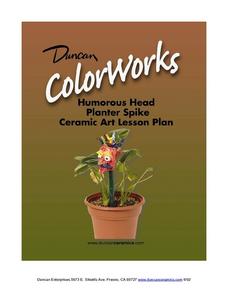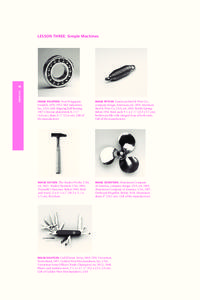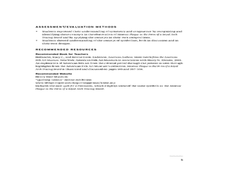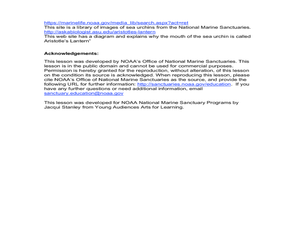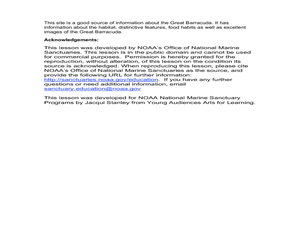Curated OER
Elements and Principles Using a Movie
Young scholars identify the elements and principles that appear in an illustration of a room and explain each concept in writing. They watch this movie identifying each of the elements and principles of design portrayed in the interiors...
Curated OER
Shape & Form
Learners analyze the difference between shape and form. They identify, explain and use the basic elements of design and determine that forms are three-dimensional and shapes are two-dimensional. They sketch it on their paper and then...
Curated OER
Soft Sculpture Birds
Art can mimic life, and animals are always interesting subjects. Learners create large soft sculptures (stuffed) birds using paper, paint, and other basic collage materials. They view images of birds, and discuss bird traits and shapes....
Curated OER
The Art Box
Sixth graders create a 3-D Art Box in this design-oriented art project for the 6th grade. Rubric is included for grading purposes. The elements of design are covered and applied (includes line, form, texture, shape, value, color, and...
Curated OER
Humourous Head Planter Spike: Ceramics Lesson
What a great activity. Kids create humorous ceramic character (heads) spikes to enliven a planter. Modern art is full of expressive and exaggerated forms and your class gets to create them out of clay. This would be a lovely activity to...
Curated OER
Understanding Symmetry Through Visual Art
Have your class explore symmetry, radial balance and fractional parts in natural and man-made objects in their environment. Learners list examples and identify symmetrical and asymmetrical designs. Pupils are given a box of crayons and...
Curated OER
Simple Machines
Students design objects in the Museum of Modern Art's collection of simple machines. In this simple machines lesson, students explore the machine age in the MoMA's design collection. Students identify simple machines and the elements in...
Curated OER
Paper Mola - Reverse appplique
Students investigate mola artwork from Panama. They discover the choices necessary to create a successful piece. Students understand the color and shape choices necessary for this art form.
Cornell University
Bridge Building
Bridge the gaps in your knowledge of bridges. Individuals learn about bridge types by building models. The activity introduces beam bridges, arch bridges, truss bridges, and suspension bridges.
Curated OER
Symmetry and Symbols
Students identify symmetrical and congruent elements in folk art. In this art and geometry instructional activity, students examine pictures of Masonic Plaque in the Form of a Royal Arch Tracing Board for evidence of congruent and...
Curated OER
Ripped Paper Art - Snowmen, Mountains and Evergreens
Young scholars discover depth in photographs or paintings by creating a picture from scrap paper. In this art analysis lesson, students practice creating depth by placing different elements higher or lower on a picture. Young...
Curated OER
Parallel-o-Home
Students investigate the usage of parallel and perpendicular shapes in the real world. In this geometry lesson, students investigate shapes for properties that are related to the real world. They relate all the properties of shape tot he...
Curated OER
A Matter of Pattern
Students will create and predict patterns formed when making paper snowflakes. Students will construct snowflakes understanding that patterns may be predicted based on observation.
Curated OER
Teaching the Bell Tetrahedral Kite
Students complete readings on kite making and kite flying. They analyze how the parts of a system interconnect and influence each other. Students identifies and uses color and form in a 3D artwork.
Curated OER
Art Appreciation
Students analyze and critique famous art prints in this introductory lesson to the appreciation of Visual Art forms. Emphasis is on classroom discussions of cultural values, prejudice, and opinions. The lesson includes possible...
Curated OER
Sea Urchins - Diadema Antillarum
Students investigate oceanography by painting sea life. In this crustacean lesson, students identify sea urchins in our ocean environments and describe the functionality of their spherical-shaped bodies. Students design their own sea...
Curated OER
A First Look at the Garden
For any teacher who is planning a field trip to Missouri's Botanical Garden, this lesson packet is a must-have! In it, young learners engage in pre-visit activities so they will be prepared to get the most out of their trip. There are...
Curated OER
Sampling Rocks
Here is a geology lesson which invites learners to explore a variety of rocks. They find rocks in the schoolyard and classify them according to size, color, and weight, then read the book Everybody Needs a Rock. Good lesson!
Core Knowledge Foundation
Rocks & Minerals
Take young geologists on an exploration of the rock cycle with this six-lesson earth science unit on rocks and minerals. Through a series of discussions, demonstrations, and hands-on investigations your class will learn...
Curated OER
Bones
Fifth graders observe real bones and models to learn about the structure and function of the skeletal system. In this skeletal system lesson, 5th graders manipulate objects and models of bones. They handle real bones and determine the...
Curated OER
The Great Barracuda
Students explore oceanography by researching the great barracuda. In this animal life lesson, students read several vocabulary terms dealing with ocean life and examine a drawing of a barracuda. Students examine the many...
Curated OER
Clay Sculpture: Relationships
Students explore art history by conducting an in-class activity. In this sculpting lesson, students examine previously created art sculptures in a textbook. Students utilize clay, sculpting tools and grey paper to create their own...
Curated OER
Andy Warhol and Silkscreen Pop Art
Students explore art history by researching famous paintings on-line. In this Andy Warhol lesson, students discuss who Warhol was, his impact on popular art and methods of painting. Students examine his use of silk screen printing and...
Curated OER
Ship-Fish or Fish-Ship
Students read two books about fishing and ships. After viewing portraits, they identify and describe the various types of sailing vessels. They discuss how the artist showed water and detailed the areas around the ships. They create...




